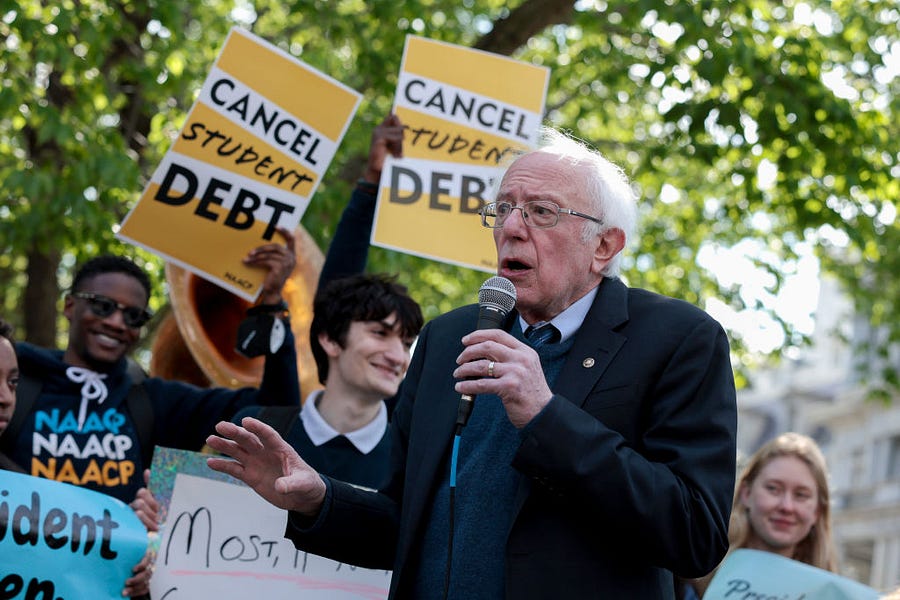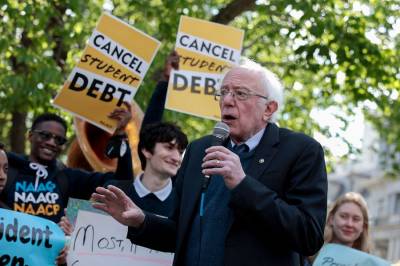Nuance is not in vogue in today’s politics. In fact, the lack of nuance may be the one common thread weaving Republicans and Democrats together. In an increasingly complicated world, we like our policy positions to be simple, preferably bifurcated. You are either pro-immigration or anti-immigration. Pro-life or pro-choice. Pro-gun or anti-gun. We scoff at the idea of receiving half a loaf when in our partisan mind we know we deserve a baker’s dozen. This is true for one of the defining issues of my generation, the $1.6 trillion in student loan debt.
In March 2020, as the world locked down to combat COVID-19, and there was hope that all we needed was two weeks to flatten the curve, 1 in 5 Americans experienced the flattening of a different curve: the interest on their student loan debt. Recognizing the incredible economic threat posed by a country and an economy on the verge of shutting down, President Donald Trump took the unprecedented step of pressing the pause button on student loans. This pause, which through congressional and executive action has lasted nearly two and a half years, not only suspended monthly student loan payments, but it also froze the accumulation of interest on student loan principals. Now, after six extensions, the pause is set to expire on August 31, 2022, but the future for borrowers remains unclear.
In 2020, Democrats eagerly outbid each other on student loan solutions. Some candidates pushed for complete loan discharge, others pressed for $50,000 in across-the-board loan forgiveness. President Biden represented a relatively moderate approach, suggesting that he would be open to forgiving $10,000 per borrower, a number that still seems to be bouncing around the White House and Department of Education.
As president, Biden continues to flirt with the possibility of broad, sweeping forgiveness, recently hinting that he would have a final decision by the end of this month. Just in time for midterm election campaigns to heat up.
In the interim, Biden has taken several bites of the proverbial elephant, including forgiving $6 billion for borrowers victimized by predatory for-profit institutions. Additionally, in early July, the Department of Education published a notice of proposed rulemaking aimed at long-term structural relief for borrowers. These new rules would strengthen the position of borrowers who fall victim to fraud or breach of contract committed by their educational institution by creating a path for complete loan discharge. The institution would ultimately carry the financial burden of the discharge. The rules would also remove several instances of interest capitalization that hamper borrowers’ ability to make progress on repayment, and make it easier to qualify for the public service loan forgiveness program.
In June, Republican Sen. Roy Blunt of Missouri, who recently received blowback from the right for his role in the bipartisan gun safety bill, spoke out against blanket student loan forgiveness. On the floor of the Senate, he emphasized the need to maintain a balanced approach to the federal government’s role in higher education, including the management of student loan debt at a time of runaway inflation:
One of the reasons I think our system works so well is … we've not tried to run higher education. We've tried to encourage and support higher education. … I think the way that we found that balance has been really important for higher education. I think it's why we have the best higher education in the world. But I think the balance is one that we ought to be thinking about maintaining.
Blunt emphasized the importance of federal Pell grants, which help low-income students fund their education, and contrasted them with student loans, which are not limited to those in economic need. In Blunt’s view, blanket forgiveness undercuts the core mission of student loans and goes beyond the funding of education into an economic policy privileging a select few:
People made a decision to invest in their education. They borrowed money to do it. The initial plan was that people would borrow money, and, as they paid it back, that money would be available for the next generation of people who wanted to borrow money. If that had worked out that way, we'd still be working off some of the first dollars that went into these student loan payments and student loan programs… What if we say that this group doesn't have to pay their debts, so maybe we should figure out other groups that shouldn't have to pay their debt? If it's a good economic policy not to pay your student debt, what if we decide we're not going to pay people's car loan debt? Or we're not going to pay people's mortgage debt? Or we're not going to pay people's credit card bills if they're somehow out of control?
In other words, in Blunt’s calculation, blanket forgiveness goes beyond the financing of education and into the realm of picking winners and losers from those who made various financial calculations. Are those who financed a home that plummeted in value any less deserving of forgiveness? How about those who run up credit card debt while launching their small business? What about those who already paid off their loans after years of belt tightening and at the expense of their long-term savings? Or people who opted for trade school or entering the job market directly because they didn’t want the burden of a loan? While these examples carry different legal dynamics, the principle remains, choosing to relieve this specific class of debt involves creating a privileged status of borrower at a time when the nation and its consumers can ill-afford it.
In June, the Consumer Price Index jumped 9.1 percent, meaning that the price of everyday consumer goods and services is greatly outpacing the rise in wages. To many, including Blunt, student loan forgiveness would only exacerbate this problem by flooding an already overly stimulated market.
“What Americans really need right now is relief from the crushing inflation we see, not more bad policies that put more money into the economy and drive inflation to an even greater height,” cautioned Sen. Blunt.
This nation does have a student loan problem, but it also has an inflation problem. The existence of one does not justify ignoring the other when a nuanced solution is so readily apparent. Blunt is right, we need to return to the government’s balanced approach to education by refocusing on assisting borrowers with repayment. This way the system can work not only for past students, but for future students as well. This can be done without writing off more than $1 trillion, and throwing more gas on the inflation fire. The real fear for borrowers is not repayment; it’s the return of interest, stupid.
The student loan freeze, including the freeze in interest accrual, has resulted in more than $100 billion in lost returns for the federal government. This alone amounts to the first blanket loan forgiveness, which has been carried out by both Republicans and Democrats, President Trump and President Biden. with no meaningful objection. While stakeholders debate the legality of executive forgiveness, the real power for change has seemingly been ceded—the manipulation of the interest rate, which is otherwise set by statute. The tenuous legal framework for the current interest freeze is contingent on the continuation of the national emergency related to COVID-19. An emergency that most of the country no longer feels nor recognizes. Therefore, lasting legal change to the interest rate must come from Congress.
Some have argued that eliminating interest entirely is the wisest path forward, including Democrat Rep. Joe Courtney of Connecticut, who described the interest as the “termite in the system” and has proposed extending the 0 percent rate into 2024. It is certainly a better option than blanket forgiveness in an age of runaway inflation, but there is room for even more nuance.
A tiered, goal-oriented approach to lowering loan interest would service multiple concerns. Prior to the freeze, many borrowers were committed to repayment but suffered from compound interest on high principals, making traditional repayment plans extremely daunting. A system of lower interest for borrowers with demonstrable need and consistent repayment would reinvigorate repayment without saddling the borrowers (and non-borrowers) with further inflation.
Likewise, there is room for a system that better incentivizes higher earners to repay early through goal-oriented benchmarks, thereby returning the money to the system at a faster rate. For example, consistent payment or “over” payments could trigger a lowering of the interest rate by staggered increments of half a percent as long as it is continued, thereby creating a snowball effect for repayment. This is not unprecedented, federal law permitted repayment incentives involving reduced interest rates until 2012. While this would result in the government forfeiting revenue on long-term interest, it returns the government to a more balanced role in the funding of education, and would still be less costly than blanket forgiveness in the short term.
Some have dismissed the potential inflationary effect of student loan forgiveness, but with $1.6 trillion in outstanding student loan debt, the increase in borrower net worth created by blanket forgiveness cannot possibly bear no effect on inflationary trends. It is likely that the freeze itself has contributed to inflation; we are just too close to recognize it. Consider the effects the COVID-era stimulus packages had on the rise of inflation. In April, FiveThirtyEight reported on the Federal Reserve Bank of San Francisco’s finding that the widely dispersed COVID-stimulus money likely contributed to inflation by as much as 3 percentage points by the end of 2021.
More recently, the Board of Governors of the Federal Reserve System published a cross-country economic study of nations that launched stimulus programs during the pandemic. In order to isolate the effects, they limited their data to dates prior to the Russian invasion of Ukraine. The study found that nations with large fiscal stimulus packages experienced “stronger inflation outbursts” caused by the slow production caused by pandemic-related supply chain issues and an uptick in consumption brought about by the stimulus.
Today, the economic output of many nations is not yet COVID-proof, and unlike the data studied by the Federal Reserve, we are living through the ripple effects of the war in Ukraine. Daily, Americans experience the ongoing effects of supply chain issues when they confront empty shelves and long delays in manufactured and consumer goods. While the stimulating effect of student loan forgiveness is not as high as the larger COVID-19 stimulus, it would undoubtedly release the buying power of a previously reticent subcategory of middle-class consumers.
Before making any rash decision on blanket forgiveness, Biden and the rest of Congress should reflect on the words of Sen. Blunt:
“I really hope that the administration will pause, will think about this, will understand the overall impact of effectively, suddenly, deciding we're going to put $321 billion [or $1.6 trillion] or so back into the economy.”
Assisting those truly hampered by debt is admirable, but saddling the borrowers and non-borrowers alike with further inflation helps neither, and may simply replace the borrowers’ debt with a new set of economic woes.






Please note that we at The Dispatch hold ourselves, our work, and our commenters to a higher standard than other places on the internet. We welcome comments that foster genuine debate or discussion—including comments critical of us or our work—but responses that include ad hominem attacks on fellow Dispatch members or are intended to stoke fear and anger may be moderated.
With your membership, you only have the ability to comment on The Morning Dispatch articles. Consider upgrading to join the conversation everywhere.